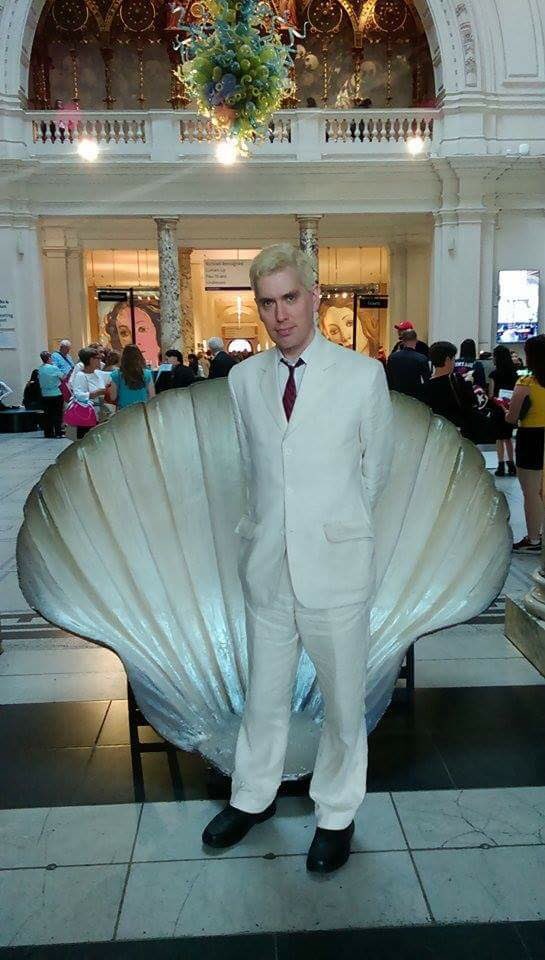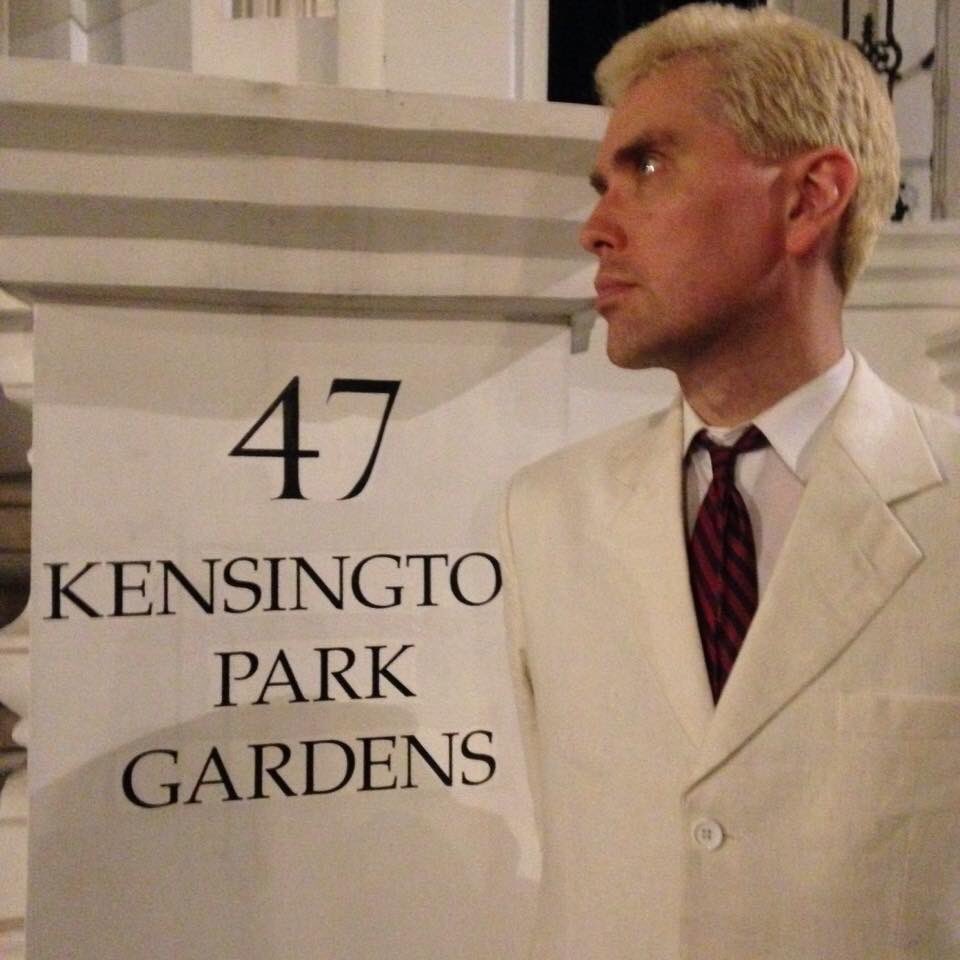Wednesday 3 August 2022. To the Wallace Collection for the exhibition Inspiring Walt Disney: The Animation of French Decorative Arts. On the audio guide is a new commentary by Angela Lansbury (I edit this entry after she dies in October, which must make the audio guide one of her last professional credits). There are stills and working drawings from some of the Disney cartoon films, mainly Cinderella and Beauty and the Beast. These are displayed alongside examples of the eighteenth-century Rococo art that inspired them, including some elaborate Sevres vases and a number of paintings from the same period.
The Wallace is home to Fragonard’s The Swing, which is often used to define the meaning of ‘Rococo’ itself. It’s only now that I realise how Disney-esque the painting is, avant la lettre: the privileged girl’s playful abandon, the sugary colours, the sense of timeless delight. Much parodied, there was a spoof cartoon in the Times during the first Covid lockdown, with the then Chancellor Rishi Sunak on the swing, throwing pink pound notes into the air in place of the pink dress. In this exhibition there’s a video screen showing a clip from Frozen, where the sister Anna jumps up in front of the painting to mimic the pose. Next to the screen is the actual painting. While Walter Benjamin might be right about a work of art losing its ‘aura’ in an age of mass reproduction, seeing the Frozen spoof on a screen alongside the actual painting has its own thrill, if a postmodern one. But then, I’m the sort of person who buys National Gallery Covid face masks.
**
Thursday 4 August 2022. With Shanthi to Café Kick in Exmouth Market, followed by drinks in the Shakespeare’s Head, before ending up performing tipsy karaoke at a private booth in Lucky Voice, Upper Street. It’s my first time, I think, since doing karaoke in a proper Tokyo hotel room-style venue, a la Lost in Translation. This was a post-gig activity by the band Spearmint, with whom I played circa 1999 and 2000. I rather like the boast of saying one only does karaoke when in Japan.
It’s too hot for a jacket, so I’m wearing purple braces over a white shirt. David B says this makes me look like a packet of Silk Cut.
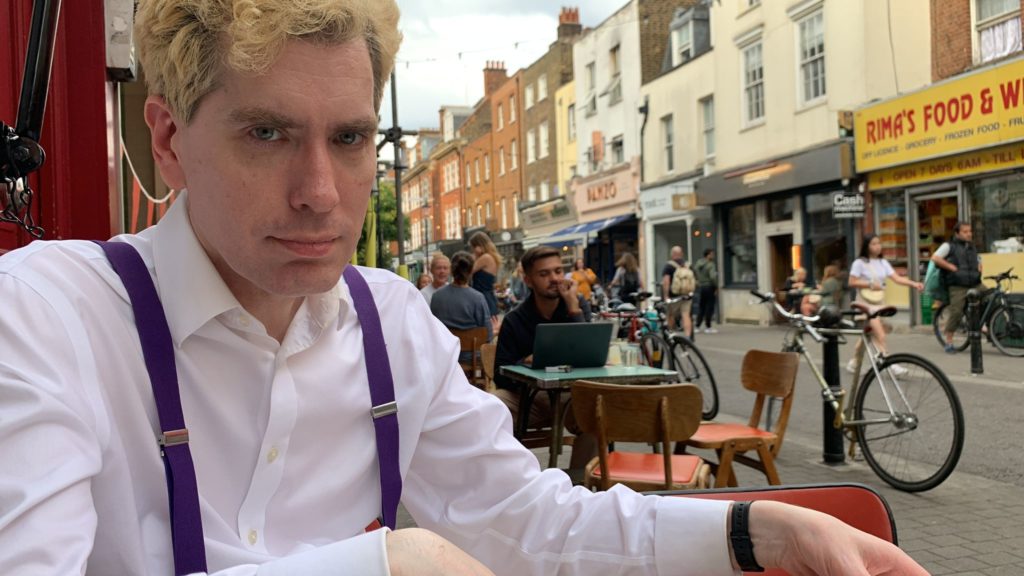
**
Sunday 7 August 2022. A recurring conversation in the media is the value of arts degrees, as opposed to studying science or business. By value, they mean the ability for arts graduates to earn large sums of money. The value of nothing and the price of everything, as someone who worked in the arts once said.
In my case, I’m certainly getting used to receiving rejection emails with the phrase: ‘due to the high volume of applications’. That really makes one feel special. It feels like there’s too many people with arts PhDs applying for too few vacancies. I believe it’s called the ‘postdocalypse’.
I’m grateful, though, that I haven’t yet been forced by the government into taking an unlovely job against my will. It’s true that one of the downsides of getting older is that the world is more likely to ignore you. But in some respects, that is one of the benefits.
**
Tuesday 9 August 2022. The Wire magazine asks me to review a book about C86, the cassette compilation of new bands put out by the NME in 1986. ‘C86’ soon came to mean a whole genre: jangly, tinny guitars, rendered in a scratchy indie rock style. On the cassette this was exemplified by bands like the Wedding Present and the Bodines. The problem with the term was that many of the other bands on the C86 tape didn’t sound that way at all. They were more arty, avant-garde and strange, more like Captain Beefheart than Orange Juice or The Smiths.
I learn from the new book that one of these artier bands, The Shrubs, was fronted by Nick Hobbs, with whom I once shared a Japanese hotel room. He managed Spearmint when I played with them, and was once impressed with me not for playing guitar but for recognising a photo on a restaurant wall of Derek Jarman’s Dungeness cottage. The implication was: what was I doing playing melodic indie pop guitar (and not very well) when I knew about Difficult Art?
This was long before Jarman became the brand he is today. Even normal people like Derek Jarman now. He’s become like Southwold, Stewart Lee, and Brutalism.
Also learned from the book: a former tambourine player with Primal Scream calls Bobby Gillespie’s autobiography a work of fiction, made to make the singer look good.
I think that’s the case with all autobiography, this diary included. There is vanity in every creative act, even when indulging in self-pity. Consciously or unconsciously, all memoirs are full of fiction, just as all novels are full of memory.
The author of the C86 book, Nige Tassell, has also written a whole book about the football transfer window, whatever that is.
**
Sunday 21 August 2022. I give a paper at an Aubrey Beardsley conference, ‘AB 150’, at St Bride’s Foundation, off Fleet Street. I enjoy the day, with the nice Beardsley aficionados, one of whom links Beardsley’s pierrot characters to costumes used by David Bowie and Harry Styles, another of whom references the film Suspiria. I reference Donald Trump, Brigid Brophy, and the film Carry on Loving. We go for drinks at the Punch Tavern, and I end up joining the Oscar Wilde Society afterwards.
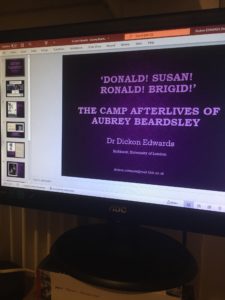
**
Thursday 25 August 2022. To the Waiting Room venue, in the basement of the Three Crowns pub, Stoke Newington. I’m here to see Charley Stone play with her own band, which she calls The Actual Band. Also on the bill are Panic Pocket: very good, intriguing and original. I chat to old friends, some not seen for years: Anna Spivack, Debbie Smith and Atalanta K, Tim Baxendale, David Barnett. I share the tube journey home with Debbie and Atalanta, who mention the documentary film that they’re both in, Rebel Dykes,about the 1980s lesbian subcultures in London.
**
Friday 26 August 2022. Treated to a kind lunch at Le Sacre Coeur in Islington, by Roz Kaveney, who knows I don’t have much money at the moment. By a coincidence Roz is also in Rebel Dykes, proving that lesbian clubs of the 80s accepted trans women too. I watch the documentary itself in the evening, via the Channel 4 streaming platform. It’s exactly the sort of alternative, subcultural film that Channel 4 used to stand for, before the era of Big Brother made it into just another mainstream channel.
Rebel Dykes depicts the busy London squat scene of the 80s, before the law was changed to make squatting illegal. This was when London, like Channel 4, was a place for the displaced. Given the current cost of living crisis, I wonder if the law will have to change again, and a new age of squatting begin.
**
Sunday 28 Aug 2022. To a mini festival in Spa Fields off Exmouth Market. There’s stalls selling food and clothes and so on, and some rock bands playing on a small stage. I’m made aware of just how visibly middle-aged the audience is, perhaps because I’ve not been to a daylight gig for a while. But then, so many of the practitioners of the genre are greying too: Paul McCartney headlining Glastonbury this year at the age of 80. Rock music now feels more claimed by the older than the young.
The C86 book, which I’m clearly not finished with, reveals that even some of the fairly obscure indie groups of the 1980s have recently reformed, the members now in their late 50s or older. This is often because there’s a proliferation of small festivals who want to book them, particularly abroad. The phrase ‘has been’ is now itself a kind of has-been. If fame just means attracting an audience, even a small one, you can stay famous forever. Or at least, for as long as YouTube exists.
After the festival I go for drinks at the very pleasant Victorian pub The Peasant, in St John Street, with Travis Elborough, Alex Mayor, and Dave Callahan, who is in the C86 book, being a member of the Wolfhounds. We are thrown out of the pub at 9pm, not because we are rowdy but because it’s a Sunday.
**
Saturday 3 September 2022. Getting older myself. I spend my 51st birthday in Bexhill on Sea, having lunch in the De La Warr Pavilion, one of those places I’ve always meant to visit. I haven’t been abroad since 2009, partly due to lack of money but also because there’s a lot of places in the UK I’ve still not ticked off.
Then afternoon tea at the wonderfully crumbling Royal Victoria hotel in St Leonards-on-Sea with Kitty Fedorec. This is close to the Marine Court Art Deco apartment block, one of my dream places to live if I had the choice, the other being the Barbican. This is followed by a game of mini golf in Hastings with her Kitty’s friends. After which we go for cheese bingo in a nearby pub, which turns out not to be a joke. I’m surrounded by wry geeks and bohemians in their 30s and 40s, one of whom is carrying a bag of vinyl albums, including Edward Woodward Sings.
**
Thursday 8 Sept 2022. The Queen dies at 96. I was convinced she would beat her mother’s age of 101, given the progress of medicine. But then, unlike her mother she did have rather more to do than drink gin and watch racehorses.
I go to the Shakespeare’s Head with David Barnett and try HMQ’s reputed tipple: Dubonnet and gin. Two parts Dubonnet to 1 part gin, with a slice of lemon plus ice.HMQ, who was not much of a drinker, inherited this choice from her mother, who was. Quite a 1920s drink, in fact, also associated with Noel Coward, and a reminder that the Queen Mother was of the Bright Young Things generation. The drink itself is not unlike absinthe. Unexpectedly strong, which seems apt. I don’t have more than one.
**
Saturday 10 September 2022. Trying to get used to having a new King, without thinking of spaniels. The Prince Charles Cinema in Soho has affixed a notice to its door: ‘No, we are not changing our name.’
**
Monday 12 September 2022. To the Barbican for The Forgiven, an Evelyn Waugh-esque melodrama about decadent white people in Morocco. I’m slightly shocked to see that film has an 18 certificate, not for violence or gore or sex but for scenes of drug use, namely cocaine. There’s some footage of Tangier early on. I think I recognise the El Minzah hotel, where there might still be a photo above the bar of me and Shane MacGowan.
**
Wednesday 21 Sept 2022. I read the comic memoir Gender Queer by Maia Kobabe. Kobabe is a young American cartoonist who mentions the music of David Bowie as part of their path to coming out as non-binary. Their other cultural references include Harry Styles. Harry Styles is not David Bowie, but there certainly seems to be a gap in the current world of role models for a Bowie-esque figure, a pretty male who can combine mainstream pop music with acting and fashion and being just unmanly enough – but too strange that he can’t appear on the cover of Grazia. Mr Styles has done his best to take up that position.
Tonight I see the big new Bowie documentary, Moonage Daydream at the BFI IMAX in Waterloo, with Shanthi and Rob, bumping into Erol Alkan in the lobby beforehand.
Moonage Daydream recycles a fair amount of footage I’ve seen before, from Alan Yentob’s Cracked Actor to the Mavis Nicholson interview. Easily found on the internet, but it’s nice to see these ancient clips cleaned up and stretched across the giant IMAX screen. Mavis Nicholson died recently, the same day as the other queen. She specialised in getting the best out of unusual men: Quentin Crisp, Kenneth Williams, Tom Baker. If I had my way, the IMAX would show a whole season of her interviews. The venue would be renamed IMAVE.
After the film Shanthi takes my photo in the IMAX Exit 1 subway, where someone has scrawled on the wall ‘PANSY MOB’.
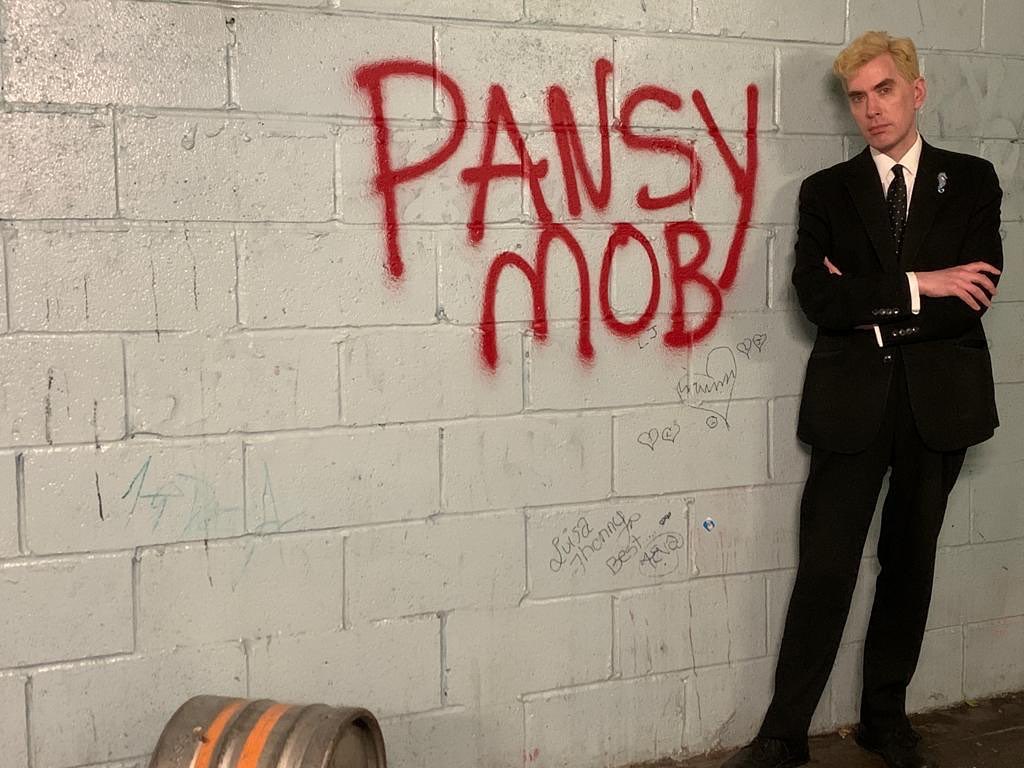
**
Friday 23 September 2022. Still on a Bowie tip, I find myself going down a Bowie / camp research rabbit-hole. In the film there’s footage of Bowie fans in the early 70s, queuing up outside one of his concerts. They chat to the camera about Bowie, saying ‘he’s so camp’, and it’s meant in a positive, even hip sense.
I find the 1972 Melody Maker Bowie interview, the one where he says he’s gay. In the article the journalist, Michael Watts, calls Bowie’s presentation ‘camp as a row of tents’. In 2006 Watts wrote about his memories of doing the interview, and wondered if he actually invented the phrase ‘camp as a row of tents’. It would be nice to think so, but I can’t resist doing the research to find out. This is what prevents me from being a regular journalist, on top of my slowness. I can’t make some sweeping claim and let it stand with no citations, no evidence.
According to Gary Simes’s exhaustive article ‘Gay Slang Lexicography’ (2005), ‘camp as a row of tents’ is at least as old as 1948, and may be Australian in its origins. Barry Humphries was using ‘camp as a row of tents’ in the 1960s, which I can believe, while the Times used the phrase in 1968, to describe the TV series The Avengers.
‘Camp’ also appears in another significant piece of Bowie journalism: Ray Coleman’s concert review for Melody Maker, 15 July 1972. There, Bowie is called ‘the undisputed king of camp rock’, combining the Velvet Underground with ‘a Danny La Rue profile’.
I wonder if young people who now look to Bowie as they look to Harry Styles would get both these references. Perhaps Todd Haynes should follow up his documentary on the Velvet Underground with one on Danny La Rue.
**
28 September 2022. So hypersensitive to language that I take against emails beginning with ‘Hi’ rather than ‘Dear’. ‘Hi’ is shrill, mercenary: a salesman who doesn’t care who you are. ‘Dear’ is an oasis of gentle.
**
30 September 2022. The last time I bought a packet of cigarettes it would have been Sobranie Cocktails. I’m delighted to be told by Kate Levey, Brigid Brophy’s daughter, that Brophy smoked them in her nursing home.
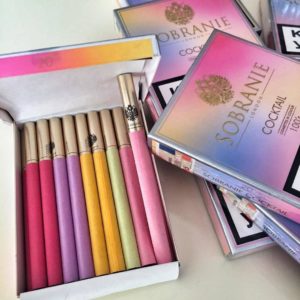
**
10 October 2022. What keeps me alive right now is my taste. One current passion is books and bookshops and indeed books about books and bookshops. I’ve read at least three such books from the latter category this year: Dennis Duncan’s Index, A History of The; Robin Ince’s Bibliomaniac,and Emma Smith’s Portable Magic. I’m also more fascinated than ever with elegance in English prose. Recently I watched a documentary about the history of the BBC and found myself drawn to a description of Winston Churchill’s manner of speaking as ‘Gibbons-esque’.
The well-honed phrase is usually best put to service in a song lyric or in a immersive narrative, style being nothing without content. But not always. Truman Capote said of Firbank that ‘all he had was style, bless him’. Sometimes it can be more than enough to just enjoy the performance of another mind.
**
Saturday 15 October 2022. Current projects: an academic chapter on Angela Carter for Bloomsbury Books, plus a novel set among studenty dandy types. I’m trying to put the camp in ‘campus novel’. One character is based on Sebastian Horsley, which seems like such an obvious thing to do. I think of Evelyn Waugh and Nancy Mitford preserving their own dandyish friends in their fiction.
**
17 October 2022. Lots of coughing about. Mum in Suffolk is now poorly with Covid for the first time, having avoided it entirely until now. Two and a half years on, though, and with the vaccines well established, one’s anxiety over the virus is a lot less acute. [Indeed, Mum goes on to recover more quickly than I did]. People are now much more worried about the cost of living, climate change, and Russia.
**
18 October 2022. I decide to get my thesis bound, choosing the style of Firbank’s first editions. Black cloth hardback, gold lettering. A reminder to myself of what I can do, and what I’ve managed to do, and that for better or worse I’m now a creature of books.
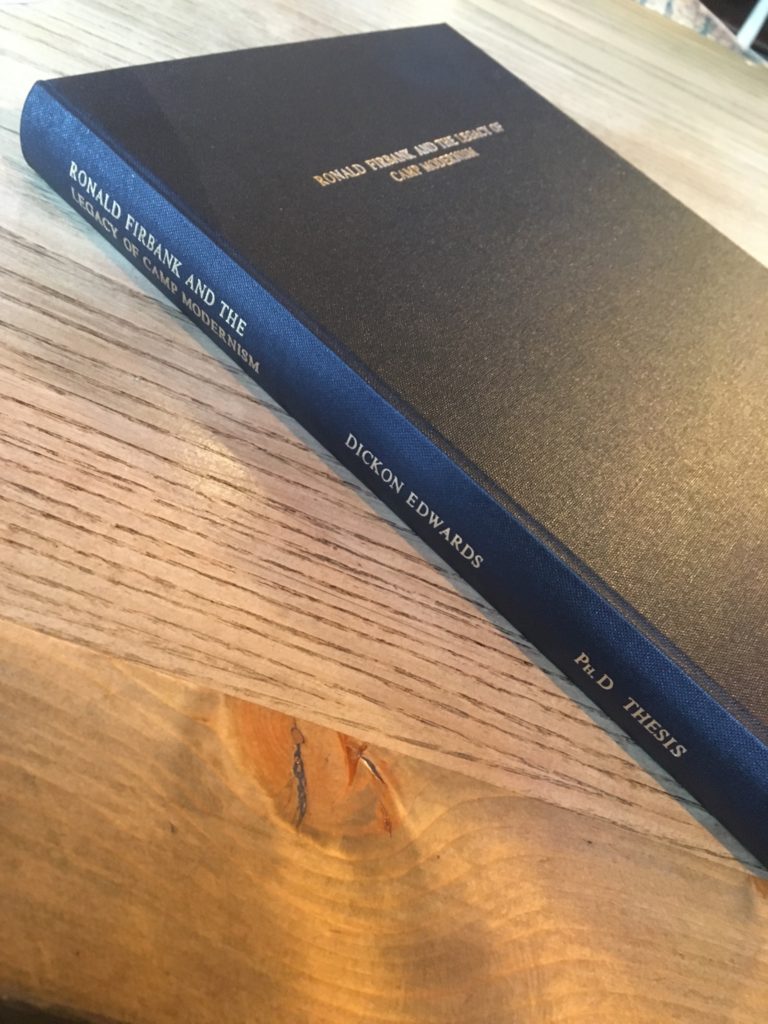
**
20 October 2022. Liz Truss follows several months of campaigning to be prime minister with barely a month in the actual job. The political news in the UK is getting so ridiculous that I feel like having a one-person riot. It will not last long but it will be very well dressed.
**
24 October 2022. I think I’ve just about got the hang of the author-date reference system now. This is from the Angela Carter article. I don’t trust referencing software, preferring to bring as much manual labour to the task as possible. It’s probably another way that I’m too slow to do this for a living, but I’m pleased with the results.
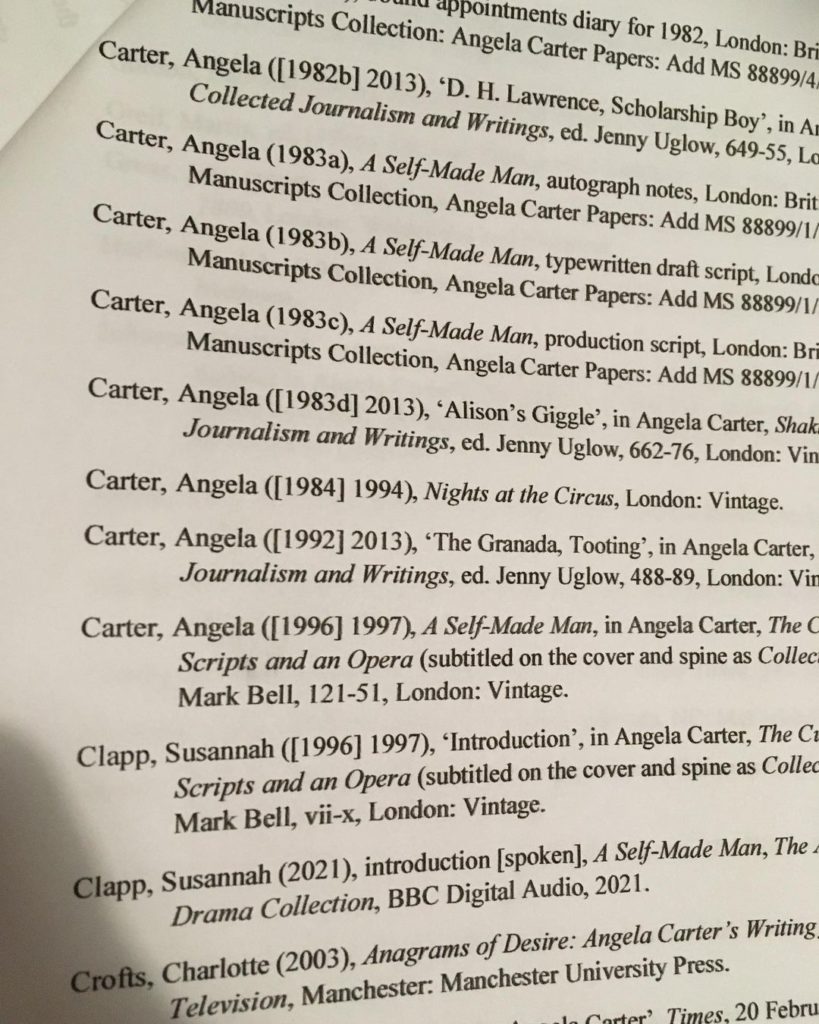
**
28 October 2022. I admire professional writers who take their time, or at least are allowed to take their time. Alan Hollinghurst taking six years to write a new book, Donna Tartt taking ten. But I also admire writers who produce regularly but who manage to do so without using a computer. At Housman’s bookshop in Kings Cross I treat myself to Ronald Blythe’s new book Next to Nature. This is a collection of his weekly Word from Wormingford column for the Church Times, which ran from the 1990s up till his retirement in 2017 aged 95. The religious content, which I’m not so interested in, is offset with Blythe’s reflections on nature, literature, and history, which I am interested in. I’m fascinated with the circumstances behind the writing: Blythe living alone since the 1970s in a lone house up a long track in the Stour Valley countryside, yet never learning to drive. He typed up his books and journalism on a typewriter and sent the copy off by post, and kept doing so into the 2010s. With writers these days churning out words like the wind, I find a sense of slowness, of polish and pause, all the more precious.
**
Saturday 5 November 2022. The computers at Birkbeck Library respond to a user logging into the system with a pop-up message of confirmation. For ten years, I used to see: ‘Dickon Edwards: Student’. Now that I’ve moved on to be an Associate Research Fellow, which is a form of unpaid affiliation, the system labels me as ‘Dickon Edwards: Other’. I read far too much into this official designation of otherness.
Going through old clutter, I find an out of date CV. Under ‘Other Work’ there is a long list. I suppose this is part of my problem. I have done too much Other Work, and not enough Normal Work. The list includes the following.
- Custodian, Kenwood House (English Heritage), 1998 to 2000. Essentially a glorified security guard, standing around in beautiful rooms full of beautiful paintings and furniture. I had to ensure visitors didn’t damage or steal anything, but I was also required to give information about the art. It meant for a crash course in Rembrandt, Vermeer, and Gainsborough, which I loved.
- Shop assistant, Archway Video DVD & VHS library, Archway Road, 2004 to 2007. I actually rebuilt the shop’s website myself, using the program Dreamweaver. Free access to films, which was bliss. And the shop was 5 minutes’ walk from my bedsit in Southwood Avenue.
- Guest columnist for Green Wedge, political website. One-off.
- Blogger for Latitude Festival.
- Gig reviewer for Drowned in Sound.
- Concert guitarist with the band Spearmint. 1999-2000. Toured the UK, Sweden and Japan. Amicably sacked for inability.
- Concert guitarist with Scarlet’s Well. 2004. Amicably sacked for inability after 1 gig, which suggests my guitar skills declined even further after Spearmint. Today I don’t own a guitar at all, having taken the hint.
- DJ at club nights ‘The Beautiful and Damned’, at the Boogaloo, Highgate, and at my own night in Camden, ‘Against Nature’. Also DJ’d at the British Library, Latitude Festival, Last Tuesday Society, Curious Invitation, White Mischief, How Does It Feel to be Loved, and other club nights. Have since thrown out my DJ CDRs along with my guitar.
- Model for the cover of the academic book Materializing Queer Desire by Elisa Glick.
- Extra in the films Shaun of the Dead (zombie in shirt and tie), Mrs Palfrey at the Claremont (party guest in suit and tie), and Gambit (restaurant diner in suit and tie).
- Life model at art classes – somewhere near Holloway Women’s Prison.
- Personal assistant, or ‘New Romantic Butler’ as one of his friends put it, to the musician Shane MacGowan, mainly for two one-off trips to Tangier, and one to New York.
- Standing for election to Haringey Council, Highgate ward, as a Green Party candidate (May 2006). Wore heavy make-up.
- Invited as guest of honour for an exhibition on menswear at the Gemeentemuseum, The Hague, Netherlands. Lent one of my suits to go on display, as an example of a modern dandy.
- Invited to be sole UK performer at the 2008 Stockholm International Poetry Festival.
And these are just the things I haven’t put on my current CV.
The world of CVs expects all people to choose one thing – a ‘career’ – aged 18, and to stick to that to the grave. I’ve never been like that. I now have a BA (1st class), MA (distinction), and a PhD, and four academic prizes, on top of my varied list of experiences. And still the job market views me as, well, too ‘Other’.
I don’t know really what to do. Except to carry on looking and applying, and to carry on writing.
**
Thursday 10 November 2022. To the Vue cinema near Angel for Bros, an American mainstream romcom about gay men. There’s a reference in the film to You’ve Got Mail, but the main character is no Meg Ryan. He doesn’t stop being neurotic long enough for the audience to care about him. His love interest, the Tom Hanks figure I suppose, is physically handsome but utterly dull. But both actors play well enough, and the ‘com’ is certainly all there, if not the ‘rom’. There’s plenty of one-liners, and I find myself laughing aloud. But it’s one of those films where I come away wondering what could have been improved.
**
Saturday 12 November 2022. Wearing a linen suit due to the unseasonal warmth. If the world is ending, one might as well look one’s best for it.
Looking for a seat on a train today, I walk past a young couple. She bursts into a manic giggle. He says, ‘What da f— was that?’ Still got it.
Saturday 19 November 2022. One of the most quoted lines from Susan Sontag’s essay ‘Notes on “Camp”‘ is:
‘It goes without saying that the Camp sensibility is disengaged, depoliticized – or at least apolitical.’
There have been many refutations of this claim ever since, often indicating the many political and subversive uses of camp, from drag queens at the Stonewall riots, to Donald Trump’s use of the Village People song ‘YMCA’ at his rallies. Sontag herself changed her mind on this position in a 1975 interview. Her own example of political camp was Mae West, arguing that she used camp as a form of feminism.
Today I watch Joe Lycett’s new stand-up show on video. He manages to blend mischief, pranks, and camp smut with a very contemporary form of social activism. His style of camp speaking is old-fashioned in the mode of Kenneth Williams, yet his material is closer to that of Michael Moore. Although Michael Moore is unlikely to refer to Lisa Scott-Lee from Steps.
If you need proof that camp can be political, Joe Lycett is it.
**
This online diary was begun in 1997. It is thought to be the longest running of its kind. The archive contains over twenty years of exclusive knowledge, all searchable and free to read without adverts or algorithms or clickbait. It depends entirely on donations by readers to keep it going. Thank you!
Tags: Angela Carter, aubrey beardsley, birkbeck, brigid brophy, Bros, c86, charley stone, david bowie, job hunting, joe lycett, Maia Kobabe, ronald blythe, sobranie cocktails, st leonard's on sea, st leonard's-on-sea, Susan Sontag, wallace collection



